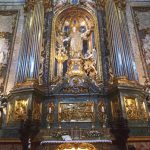150 YEARS OF THE NAZARETH SISTERS
In the footsteps of Blessed Frances Siedliska in Rome (12)
Sr. M. Beata Rudzińska, CSFN

Chiesa del Gesù
Today we will again stop for a moment at the Jesuit Church of the Most Holy Name of Jesus. Every group of Sisters I accompanied on the Foundress’ path was impressed by this place.
St. Ignatius twice tried to begin construction of a large church to replace the chapel of Our Lady of the Way (Madonna della Strada) donated by the Pope. However, protests from neighbors and, above all, a lack of funds stood in the way. It was not until St. Francis Borgia, the third general of the Society, that the construction began. The work, financed mainly by Cardinal Alexander of the wealthy Farnese family, lasted from 1568 to 1584. Il Gesù is the prototype of many Baroque churches, including the Church of St. Peter and Paul on Grodzka Street in Cracow.
Upon entering the church, one’s attention is drawn to the beautiful chancel and the vaulted ceiling with the “Triumph of the Name of Jesus” fresco, which one can “zoom in” by looking at the large mirror set up just by the entrance. Various illusionistic effects add even more appeal to the grandly painted vision of heaven.
Passing a series of beautifully decorated chapels, we arrive first at the altar where the relics of St. Ignatius Loyola rest, and then at the chapel where the venerated Madonna della Strada icon was transferred. This most likely 13th-century image was also very dear to Francis. Sr. Tarsycja Bzowska, who joined the Congregation during the Foundress’ lifetime, recalls that she was once with her in the Jesuits’ church. Mother, pointing to the icon of the Mother of God, told her that she had prayed there for many hours before receiving the papal blessing.
Moving to the opposite nave, we first enter the chapel with the Blessed Sacrament and with the probably world-famous image of the Heart of Jesus. The next altar, exactly opposite the altar of St. Ignatius, is dedicated to one of his first companions – St. Francis Xavier. Visitors from Asia often pray before the relic of his arm. After all, it was he who first brought them the Gospel.
Visitors to the church also note the new chancel decor, boldly combining “the old with the new.” The renewal, completed in 2022, was inspired by the Second Vatican Council’s Constitution on the Sacred Liturgy “Sacrosanctum Concilium.” One of the elements of the new decor that the Sisters ask about is a ciborium suspended above the altar with the words from Revelation engraved in Greek: And the Spirit and the Bride say, “Come!” And he who hears, let him say: “Come!” The One who testifies says: “Indeed, I will come soon.” Amen. Come, Lord Jesus!
Let the importance of Del Gesù Church for the Congregation be evidenced by the fact that during the thanksgiving triduum for the beatification of our Foundress, solemn liturgies in Italian and Polish were celebrated here. Only the English day was celebrated in the Basilica of Santa Maria Maggiore, particularly associated with the founding of our mission in the US.
It is also worth mentioning that in this church, in 1970, thanksgiving for the beatification of Maximilian Kolbe, and in 1978 for the election of Karol Wojtyla as Pope were held. Until 1938, St. Andrew Bobola also rested here. After his canonization, his relics were transported to Warsaw.
We will not return to Del Gesù in these posts. However, I hope that many of us will have the opportunity to do so in person…
Pictures: S. Anita Jach CSFN
Vault of the chancel and nave, close-up in the mirror
The altar of St. Ignatius
Sr. Amata Nowaszewska CSFN
Icon of the Madonna della Strada
Chapel of the Sacred Heart of Jesus
Renovated presbytery – www.gesuiti.it






